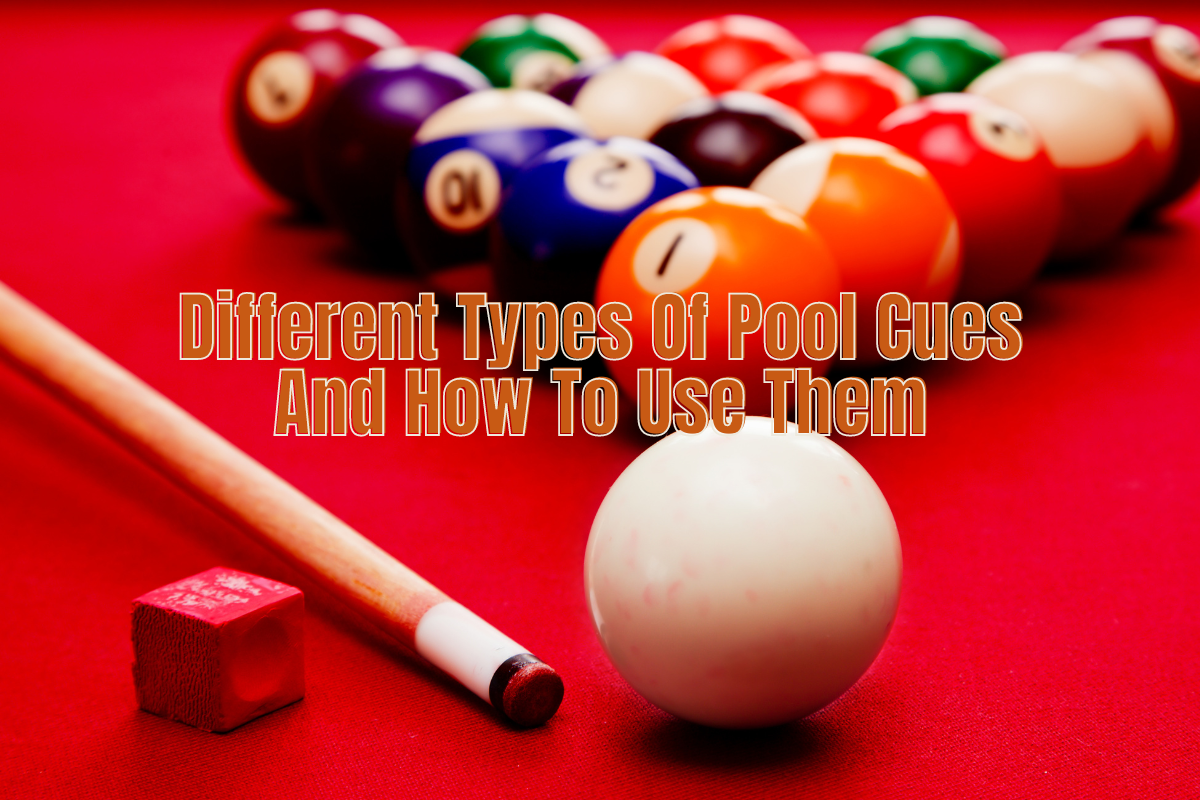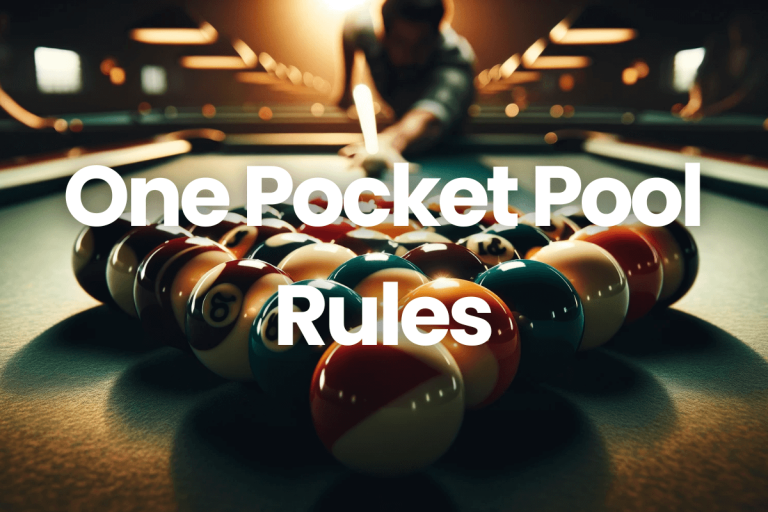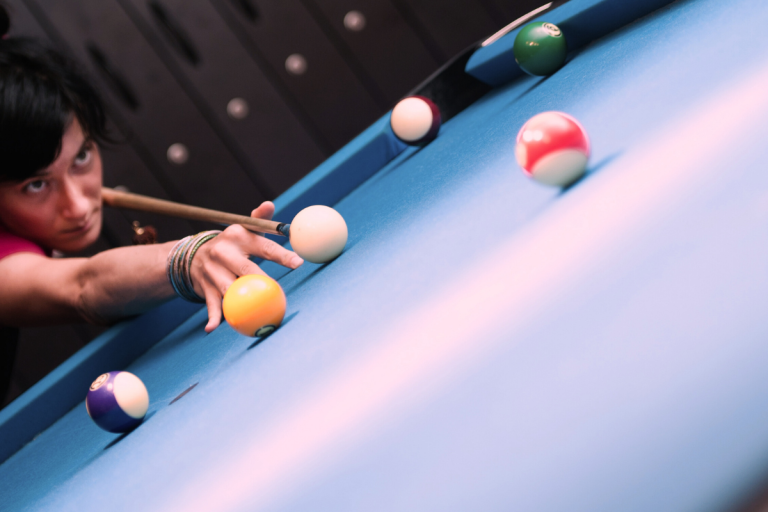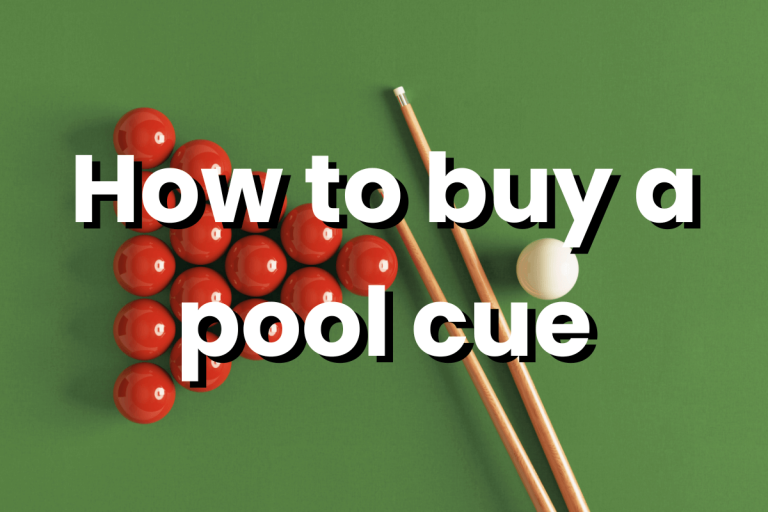Different Types of Pool Cues | Find the Perfect Cue (2024)
Pool cues, more than just equipment, are an extension of the player’s skill and style. Understanding the ‘Different Types of Pool Cues and How to Use Them’ is crucial for both beginners and seasoned players alike. Each type of cue, from the powerful American pool cues to the discreet Sneaky Pete, serves a unique purpose and enhances different aspects of the game. In this guide, we’ll explore the diverse world of pool cues, delving into their distinct characteristics and how to effectively utilize them. Whether you’re aiming to refine your break shot or execute precise spins, the right cue can make all the difference.
Different Types of Pool Cues
Here are all types of pool cues:
- One-Piece Cues.
- Two-Piece Cues.
- Low-Deflection Cues.
- Sneaky Pete Pool Cues.
- Short Pool Cues.
- American Pool Cues.
- English Pool Cues.
- Jump Cues.
- Break Cues.
- Snooker Cues.
- Carom Cues.
- Custom Cues.
One-Piece Cues
Characteristics: Crafted from a single piece of wood, one-piece cues are known for their simplicity and durability. Often found at a lower price point compared to other cues.
Usage: These cues are frequently seen in pool halls and bars, serving as reliable options for casual play. While offering a consistent feel and solid performance, their lack of joint construction makes them less portable, and ideal for stationary use.
Two-Piece Cues
Characteristics: Designed with a threaded joint, two-piece cues can be easily separated into two sections for convenient transport and storage. This modular construction also allows for customization of shafts and butts.
Usage: Widely favored by players who value portability and versatility, two-piece cues offer a balance of performance and convenience. Many enthusiasts appreciate the ability to interchange shafts or personalize their cue setup to suit their playing style and preferences.
Low-Deflection Cues
Characteristics: Featuring a specially engineered shaft, low-deflection cues minimize cue ball deflection, also known as “squirt,” when applying English or side spin. This design enhances accuracy by reducing the amount the cue ball deviates from its intended path.
Usage: Particularly favored by players who frequently apply English to their shots, low-deflection cues offer improved control and precision, allowing for more accurate aiming and consistent performance on the table. With reduced squirt, players can confidently execute shots with greater confidence and reliability.
Sneaky Pete Pool Cues
Characteristics: Crafted to resemble ordinary house cues, Sneaky Pete cues possess the craftsmanship and performance of professional-grade cues, often featuring intricate woodwork and elegant designs.
Usage: Skilled players appreciate Sneaky Pete cues for their discreet appearance, allowing them to blend in seamlessly while delivering exceptional playability and control. These cues are favored by those who prioritize quality without attracting undue attention to the pool table.
Short Pool Cues
Characteristics: Shorter than standard cues, typically around 36 to 48 inches.
Usage: Perfect for tight spaces or for children. They offer the same functionality as standard cues but are easier to handle in limited space.
American Pool Cues
Characteristics: American pool cues are known for their versatility and durability, often weighing between 18 to 21 ounces and featuring larger tips ranging from 11.5 to 13.5 millimeters. These cues are commonly crafted from high-quality maple wood, renowned for its strength and resilience.
Usage: Well-suited for a variety of games including eight-ball, nine-ball, and straight pool, American pool cues offer players a solid feel and enhanced control. The heavier weight aids in delivering powerful break shots, while the larger tip facilitates accurate cue ball control, making them popular choices among players of all skill levels.
English Pool Cues
Characteristics: English pool cues are typically lighter in weight, ranging from 17 to 19 ounces, and feature smaller tips measuring around 8 to 11 millimeters in diameter. These cues are commonly crafted from ash wood, known for its flexibility and responsiveness.
Usage: Perfectly suited for English pool games such as blackball and snooker, these cues offer players exceptional ball control and precision. The lighter weight allows for swift and delicate shots, while the smaller tip facilitates accurate cue ball manipulation, making them essential tools for finesse-oriented players.
Jump Cues
Characteristics: Jump cues are typically shorter in length, lightweight, and feature an extremely hard tip, often made of phenolic resin or carbon fiber, designed for increased precision and power.
Usage: These specialized cues are exclusively used for executing jump shots, allowing players to elevate the cue ball over obstacles such as other balls or snooker cues. Their compact design and rigid tip facilitate maximum cue ball height and distance, making them essential tools for mastering advanced shots and gaining a competitive edge on the pool table.
Break Cues
Characteristics: Break cues are distinguished by their heavier weight and sturdier construction, often featuring a reinforced ferrule and a phenolic tip known for its hardness and durability.
Usage: Specifically engineered for break shots, these cues are designed to deliver maximum power and impact on the cue ball, resulting in an explosive break that effectively disperses the balls across the table. Their robust build and rigid tip ensure optimal energy transfer, making them indispensable tools for achieving a strong and controlled break in various cue sports such as pool and snooker.
Snooker Cues
Characteristics: Snooker cues typically have a medium weight ranging from 18 to 20 ounces, with tips varying between 9.5 to 10.5 millimeters in diameter. These cues are often constructed from high-quality ash wood, renowned for its strength and responsiveness.
Usage: Specifically engineered for the game of snooker, these cues excel in providing players with the precision and control required for executing long, straight shots on the expansive snooker table. Their medium weight ensures a balanced feel, allowing players to deliver consistent and accurate strokes with finesse.
Carom Cues
Characteristics: Similar to snooker cues but with a thicker build.
Usage: Used in carom billiards, focusing on caroms (cannon) rather than pocketing balls.
Custom Cues
Characteristics: Tailored to individual preferences in weight, length, and design.
Usage: For players seeking a personalized experience, often incorporating specific grip styles, balance points, and aesthetics.
How to Choose the Right Pool Cue for You
There are a few things to consider when choosing the right pool cue for you:
- Your playing style: If you’re a power player, you’ll need a cue that’s heavy and has a large tip. If you’re a finesse player, you’ll need a cue that’s lighter and has a smaller tip.
- Your budget: Pool cues can range in price from a few hundred dollars to a few thousand dollars. It’s important to set a budget before you start shopping.
- Your personal preferences: Some people prefer cues with wooden shafts, while others prefer cues with carbon fiber shafts. Some people prefer cues with leather tips, while others prefer cues with phenolic tips. It’s important to choose a cue that you feel comfortable with.
Conclusion
As we wrap up our thrilling expedition through the world of pool cues, I’m reminded of the profound impact a cue can have on your game. Just like a maestro with their baton, your choice of cue becomes a dance partner, guiding you to finesse and power. From the classic elegance of one-piece cues to the crafty intrigue of Sneaky Pete cues, we’ve uncovered a treasure trove of cue artistry. Armed with the knowledge of various cues, you’re now equipped to step onto the felt with newfound confidence. So, embrace your cue persona, make each shot a symphony, and let your cue mastery shine like the true cue virtuoso you are!
FAQs
Can I Switch Between Different Cue Types?
Switching cues based on the shot at hand is a skillful tactic embraced by many players. It allows you to optimize your performance for specific scenarios, ensuring you’re always in control of the table. Just like a painter selecting different brushes for various strokes, cue artists choose cues to paint their path to victory.
What are the different materials that pool cues can be made from?
Pool cues can be made from a variety of materials, including wood, carbon fiber, and fiberglass. Wood cues are the most traditional type of cue, and they offer a good balance of power and control. Carbon fiber cues are lighter and more durable than wood cues, but they can be more expensive. Fiberglass cues are the most affordable type of cue, but they’re not as durable as wood or carbon fiber cues.
How should I care for my pool cue?
Keep your cue in case when you’re not using it. This will help protect it from damage. Avoid hitting your cue on hard surfaces. This can damage the shaft and tip. Clean your cue regularly with a soft cloth. This will remove dirt and grime that can build up over time. Apply a cue wax to the shaft and tip. This will help protect the wood and leather.
What are the main differences between American and English pool cues?
American pool cues are generally heavier and have larger tips, typically ranging from 12 to 13 mm, making them ideal for powerful shots and breaks. In contrast, English pool cues are lighter, with smaller tips around 8 to 9 mm, offering more control and precision for the finesse required in English pool games.
How do I choose between a one-piece and a two-piece pool cue?
One-piece cues are often used in pool halls and provide a consistent feel, but they’re not convenient for travel. Two-piece cues, which can be disassembled, are preferred by players who need portability. They also offer the flexibility to change shafts or butts for different playing styles or conditions. Your choice should be based on your primary playing location and personal preference for cue handling.







